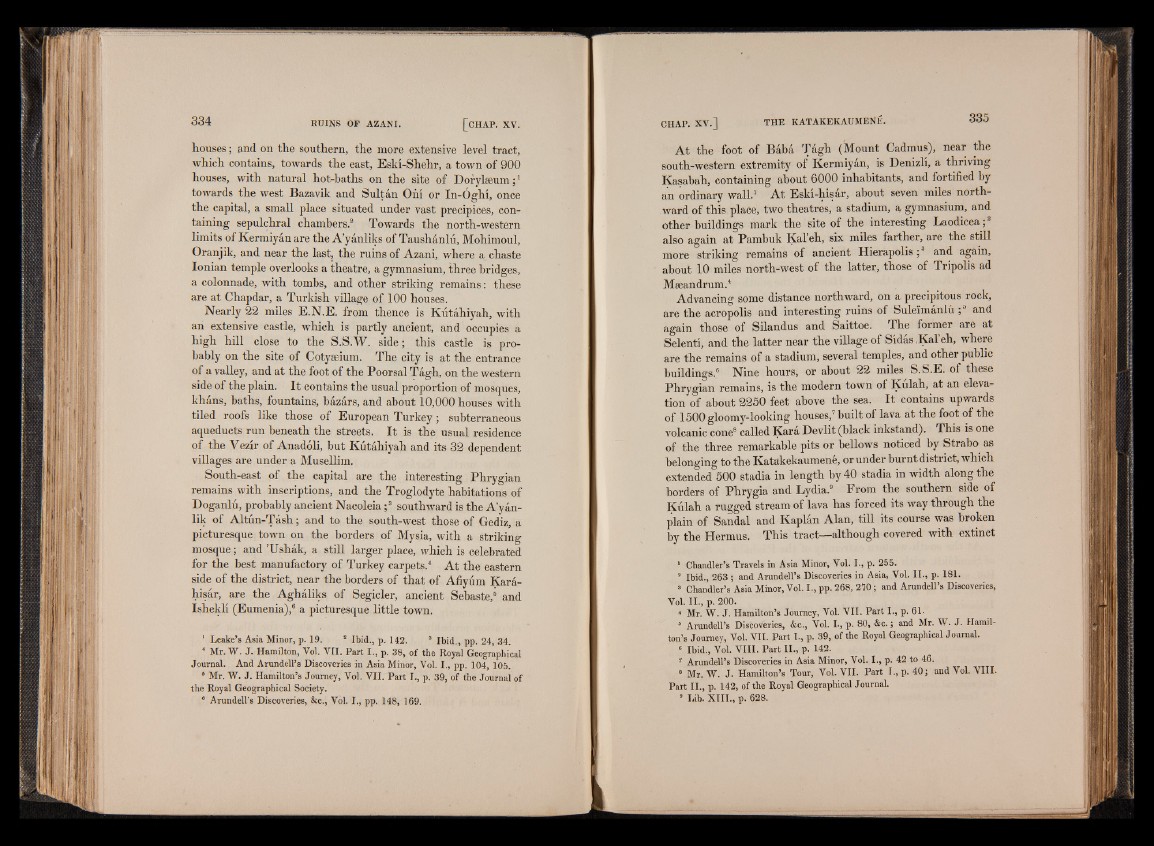
houses; and on the southern, the more extensive level tract,
which contains, towards the east, Eski-Shehr, a town of 900
houses, with natural hot-baths on the site of Dorylseum;1
towards the west Bazavik and Sultán Oñi or In-Óghí, once
the capital, a small place situated under vast precipices, containing
sepulchral chambers.3 Towards the north-western
limits of Kermiyán are the A’yánliks of Taushánlú, Mohimoul,
Oranjik, and near the last, the ruins of Azani, where a chaste
Ionian temple overlooks a theatre, a gymnasium, three bridges,
a colonnade, with tombs, and other striking remains: these
are at Chapdar, a Turkish village of 100 houses.
Nearly 22 miles E.N.E. from thence is Kútáhiyah, with
an extensive castle, which is partly ancient, and occupies a
high hill close to the S.S.W. side; this castle is probably
on the site of Cotyeeium. The city is at the entrance
of a valley, and at the foot of the Poorsal Tág-h, on the western
side of the plain. It contains the usual proportion of mosques,
kháns, baths, fountains, bázárs, and about 10,000 houses with
tiled roofs like those of European Turkey; subterraneous
aqueducts run beneath the streets. It is the usual residence
of the Vezir of Anadóli, but Kútáhiyah and its 32 dependent
villages are under a Musellim.
South-east of the capital are the interesting Phrygian
remains with inscriptions, and the Troglodyte habitations of
Doganlú, probably ancient Nacoleia ;3 southward is the A’yán-
lik of Altún-Tásh; and to the south-west those of Gediz, a
picturesque town on the borders of Mysia, with a striking
mosque; and ’Ushák, a still larger place, which is celebrated
for the best manufactory of Turkey carpets.4 At the eastern
side of the district, near the borders of that of Afiyúm Kará-
hisár, are the Agháliks of Segicler, ancient Sebaste,6 and
Ishekli (Eumenia),6 a picturesque little town.
1 Leake’s Asia Minor, p. 19. 8 Ibid., p. 142. 3 Ibid., pp. 24, 34.
4 Mr. W. J . Hamilton, Vol. VII. Part I., p. 38, of the Royal Geographical
Journal. And Arundell’s Discoveries in Asia Minor, Vol. I., pp. 104, 105.
8 Mt . W . J. Hamilton’s Journey, Vol. VII. Part I., p. 39, of the Journal of
the Royal Geographical Society.
8 Arundell's Discoveries, &c., Vol. I., pp. 148, 169.
At the foot of Baba Tagh (Mount Cadmus), near the
south-western extremity of Kermiyan, is Denizli, a thriving
Kasabah, containing about 6000 inhabitants, and fortified by
an ordinary wall.1 At Eski-hisar, about seven miles northward
of this place, two theatres, a stadium, a gymnasium, and
other buildings mark the site of the interesting Laodicea;2
also again at Pambuk Kal’eh, six miles farther, are the still
more striking remains of ancient Hierapolis ;3 and again,
about 10 miles north-west of the latter, those of Tripolis ad
Mseandrum.4
Advancing some distance northward, on a precipitous rock,
are the acropolis and interesting ruins of Suleimanlu ; and
again those of Silandus and Saittoe. The former are at
Selenti, and the latter near the village of Sidas Kal’eh, where
are the remains of a stadium, several temples, and other public
buildings.6 Nine hours, or about 22 miles S.S.E. of these
Phrygian remains, is the modern town of Kulah, at an elevation
of about 2250 feet above the sea. It contains upwards
of 1500 gloomy-looking houses,7 built of lava at the foot of the
volcanic cone8 called Kara Devlit (black inkstand). This is one
of the three remarkable pits or bellows noticed by Strabo as
belonging to the Katakekaumene, or under burnt district, which
extended 500 stadia in length by 40 stadia in width along the
borders of Phrygia and Lydia.9 From the southern side of
Kulah a rugged stream of lava has forced its way through the
plain of Sandal and Kaplan Alan, till its course was broken
by the Hermus. This tract—although covered with extinct
1 Chandler’s Travels in Asia Minor, Vol. I., p. 255.
2 Ibid., 263 ; and Arundell’s Discoveries in Asia, Vol. II., p. 181.
8 Chandler’s Asia Minor, Vol. I., pp. 268, 210; and Arundell’s Discoveries,
Vol. II., p. 200.
1 Mr. W. J . Hamilton’s Journey, Vol. VII. Part I., p. 61.
5 Arundell’s Discoveries, &c., Vol. I., p. 80, &c.; and Mr. W. J. Hamilton’s
Journey, Vol. VII. Part I., p. 39, of the Royal Geographical Journal.
6 Ibid., Vol. V III. Part II., p. 142.
7 Arundell’s Discoveries in Asia Minor, Vol. I., p. 42 to 46.
8 Mr. W. J . Hamilton’s Tour, Vol. VII. Part I., p. 4 0 ; and Vol. VIII.
Part II., p. 142, of the Royal Geographical Journal.
9 Lib. X III., p. 628.